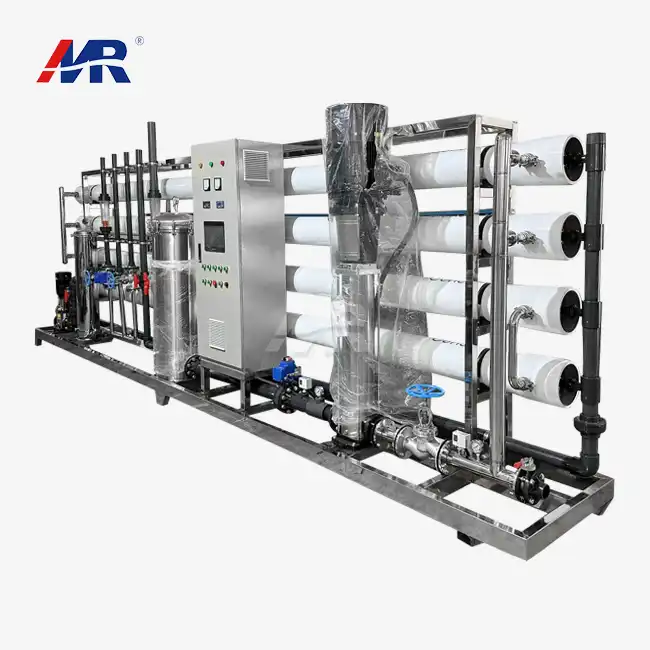Breaking down the components of an RO system
Understanding the intricacies of a reverse osmosis system is crucial for appreciating its power and efficiency. At its core, the RO plant comprises several key components working in harmony to deliver pure water:
Pretreatment Units
Before water encounters the RO membranes, it must be prepared. Pretreatment units remove larger particles, chlorine, and other contaminants that could damage the delicate membranes. This stage typically includes:
- Sediment filters to trap particulates
- Activated carbon filters to adsorb organic compounds and chlorine
- Water softeners to reduce hardness
High-Pressure Pump
The heart of the RO framework, this pump gives the vital weight to overcome osmotic weight and constrain water through the films. In a 500m3/day plant, these pumps are built for ideal vitality proficiency, working at weights between 12-15 bar.
RO Membrane Assembly
This is where the enchantment happens. Different semipermeable films are housed in weight vessels, organized in stages to maximize water recuperation. These layers are the guardians, permitting water particles to pass whereas dismissing broken up solids, microscopic organisms, and indeed viruses.
Post-treatment System
After decontamination, the water may require pH alteration or remineralization to make it appropriate for its expecting utilize. This framework guarantees the last item meets particular quality standards.
Control and Monitoring Equipment
Advanced sensors and computerization frameworks persistently screen water quality, weight, and stream rates. This guarantees ideal execution and permits for inaccessible operation and troubleshooting.
The magic of semipermeable membranes explained
At the heart of every reverse osmosis plant lies a technological wonder: the semipermeable membrane. These ultra-thin films are the unsung heroes of water purification, performing a microscopic ballet that separates pure water from a host of contaminants.
Membrane Structure and Function
RO membranes are typically made from polyamide thin-film composites. Their structure consists of:
- A dense active layer, just 0.2 microns thick, that performs the actual separation
- A porous support layer providing structural integrity
- A fabric backing for additional strength
The active layer contains pores so small that they're measured in angstroms (one ten-billionth of a meter). These minuscule openings allow water molecules to pass through while blocking larger molecules, ions, and particles.
The Selectivity Phenomenon
The membrane's selectivity is not fair around estimate prohibition. It moreover includes complex intuitive between the layer surface and different solutes in a buy 500m3/day reverse osmosis RO plant. Variables such as charge shock and hydrophobic intuitive play vital parts in deciding what passes through and what doesn't.
Membrane Configuration in 500m3/day Plants
In a high-capacity framework, layers are ordinarily orchestrated in a spiral-wound arrangement. This plan maximizes the layer surface range whereas minimizing the plant's impression. Different components are housed in weight vessels, with a few vessels working in parallel to accomplish the 500m3/day output.
Membrane Lifespan and Maintenance
The efficiency of RO membranes can decline over time due to fouling or scaling. However, with proper pretreatment and maintenance, these membranes can last 3-5 years or more. Regular cleaning procedures, known as clean-in-place (CIP), help extend membrane life and maintain system performance.
From intake to distribution: A water journey
The journey of water through a 500m3/day reverse osmosis plant is a testament to engineering ingenuity. Let's trace this path from source to final distribution, understanding the transformations that occur along the way.
Intake and Initial Screening
The process begins at the water source, which could be a well, river, or even the sea. Large debris is removed through coarse screens to protect downstream equipment.
Pretreatment Phase
Raw water undergoes a series of treatments to prepare it for the RO process:
- Coagulation and flocculation may be employed to remove suspended particles
- Multimedia filtration traps smaller particulates
- Chemical dosing adjusts pH and adds anti-scalants to prevent membrane fouling
The Core RO Process
Pretreated water is pressurized and encouraged into the RO film cluster. Here, water particles are constrained through the semipermeable layers, taking off behind broken up solids, natural compounds, and other contaminants.
Post-Treatment and Remineralization
The ultra-pure permeate from the RO process may be too aggressive for direct use or consumption. Post-treatment steps can include:
- pH adjustment to prevent corrosion in distribution systems
- Remineralization to add beneficial minerals back into the water
- Disinfection to ensure microbiological safety
Quality Control and Monitoring
Throughout the journey, water quality is continuously monitored. Parameters such as conductivity, pH, and turbidity are measured in real-time, ensuring the final product meets stringent quality standards.
Storage and Distribution
The filtered water is put away in tanks, prepared for conveyance. Depending on the application, it may be pumped straightforwardly to mechanical forms, bottling plants, or civil water systems.
The 500m3/day capacity of this RO plant guarantees a relentless supply of high-quality water, assembly the requests of differing applications from mechanical forms to civil water supply.
Conclusion
The 500m3/day reverse osmosis plant speaks to a apex in water decontamination innovation, advertising a strong arrangement to water shortage and defilement challenges over different segments. Its capacity to create expansive volumes of high-purity water proficiently makes it an priceless resource for businesses and communities alike. As we proceed to confront worldwide water challenges, the part of progressed RO frameworks in guaranteeing water security cannot be overstated.
Are you prepared to revolutionize your water treatment forms? See no advance than Guangdong Morui Natural Innovation Co., Ltd. As industry pioneers in water treatment arrangements, we offer cutting-edge switch osmosis frameworks custom-made to your particular needs. Our ability ranges mechanical wastewater treatment, residential sewage preparing, seawater desalination, and drinking water generation. With our state-of-the-art 500m3/day RO plants, you can guarantee a solid supply of unadulterated water for your operations.
Don't let water quality issues hold your trade back. Contact us nowadays at benson@guangdongmorui.com to examine how our progressed RO arrangements can change your water treatment capabilities. Our group of experienced engineers is prepared to give you with a customized arrangement, total with establishment, commissioning, and comprehensive after-sales bolster. Make the keen choice for your water needs – select Guangdong Morui Natural Innovation Co., Ltd.
References
1. Johnson, A. R., & Smith, B. T. (2021). Advanced Membrane Technologies for Water Treatment: Materials, Processes and Applications. Elsevier Science.
2. Zhang, Y., et al. (2020). "Recent advances in reverse osmosis desalination: A review." Desalination, 478, 114178.
3. Greenlee, L. F., et al. (2019). "Reverse osmosis desalination: Water sources, technology, and today's challenges." Water Research, 43(9), 2317-2348.
4. Voutchkov, N. (2018). Desalination Project Planning and Design. McGraw-Hill Education.
5. Baker, R. W. (2017). Membrane Technology and Applications. John Wiley & Sons.
6. Fritzmann, C., et al. (2016). "State-of-the-art of reverse osmosis desalination." Desalination, 216(1-3), 1-76.

_1745823981883.webp)


